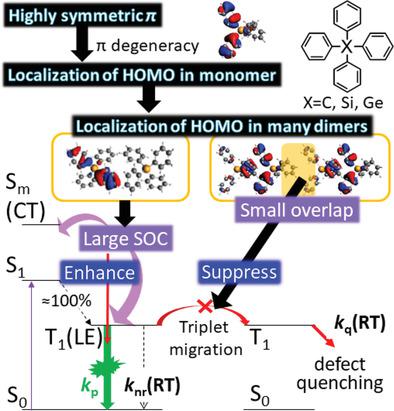Our official English website, www.x-mol.net, welcomes your
feedback! (Note: you will need to create a separate account there.)
Roles of Localized Electronic Structures Caused by π Degeneracy Due to Highly Symmetric Heavy Atom‐Free Conjugated Molecular Crystals Leading to Efficient Persistent Room‐Temperature Phosphorescence
Advanced Science ( IF 14.3 ) Pub Date : 2019-05-10 , DOI: 10.1002/advs.201900410 Shuzo Hirata 1
Advanced Science ( IF 14.3 ) Pub Date : 2019-05-10 , DOI: 10.1002/advs.201900410 Shuzo Hirata 1
Affiliation

|
Conjugated molecular crystals with persistent room‐temperature phosphorescence (RTP) are promising materials for sensing, security, and bioimaging applications. However, the electronic structures that lead to efficient persistent RTP are still unclear. Here, the electronic structures of tetraphenylmethane (C(C6H5)4), tetraphenylsilane (Si(C6H5)4), and tetraphenylgermane (Ge(C6H5)4) showing blue‐green persistent RTP under ambient conditions are investigated. The persistent RTP of the crystals originates from minimization of triplet exciton quenching at room temperature not suppression of molecular vibrations. Localization of the highest occupied molecular orbitals (HOMOs) of the steric and highly symmetric conjugated crystal structures decreases the overlap of intermolecular HOMOs, minimizing triplet exciton migration, which accelerates defect quenching of triplet excitons. The localization of the HOMOs over the highly symmetric conjugated structures also induces moderate charge‐transfer characteristics between high‐order singlet excited states (Sm) and the ground state (S0). The combination of the moderate charge‐transfer characteristics of the Sm–S0 transition and local‐excited state characteristics between the lowest excited triplet state and S0 accelerates the phosphorescence rate independent of the vibration‐based nonradiative decay rate from the triplet state at room temperature. Thus, the decrease of triplet quenching and increase of phosphorescence rate caused by the HOMO localization contribute to the efficient persistent RTP of Ge(C6H5)4 crystals.
中文翻译:

高度对称的无重原子共轭分子晶体导致 π 简并导致高效持久室温磷光的局域电子结构的作用
具有持久室温磷光(RTP)的共轭分子晶体是用于传感、安全和生物成像应用的有前途的材料。然而,导致高效持久RTP的电子结构仍不清楚。此处,四苯基甲烷 (C(C 6 H 5 ) 4 )、四苯基硅烷 (Si(C 6 H 5 ) 4 ) 和四苯基锗烷 (Ge(C 6 H 5 ) 4 ) 的电子结构在环境下显示出蓝绿色持久 RTP条件进行调查。晶体的持久RTP源于室温下三重态激子猝灭的最小化,而不是抑制分子振动。空间和高度对称共轭晶体结构的最高占据分子轨道(HOMO)的局域化减少了分子间HOMO的重叠,最大限度地减少了三重态激子迁移,从而加速了三重态激子的缺陷淬灭。 HOMO 在高度对称共轭结构上的局域化也导致了高阶单重激发态 (S m ) 和基态 (S 0 ) 之间的适度电荷转移特性。 S m –S 0跃迁的适度电荷转移特性和最低激发三重态与 S 0之间的局域激发态特性的组合加速了磷光速率,与三重态基于振动的非辐射衰减率无关。室温。 因此,HOMO局域化引起的三线态猝灭的减少和磷光速率的增加有助于Ge(C 6 H 5 ) 4晶体的有效持久RTP。
更新日期:2019-05-10
中文翻译:

高度对称的无重原子共轭分子晶体导致 π 简并导致高效持久室温磷光的局域电子结构的作用
具有持久室温磷光(RTP)的共轭分子晶体是用于传感、安全和生物成像应用的有前途的材料。然而,导致高效持久RTP的电子结构仍不清楚。此处,四苯基甲烷 (C(C 6 H 5 ) 4 )、四苯基硅烷 (Si(C 6 H 5 ) 4 ) 和四苯基锗烷 (Ge(C 6 H 5 ) 4 ) 的电子结构在环境下显示出蓝绿色持久 RTP条件进行调查。晶体的持久RTP源于室温下三重态激子猝灭的最小化,而不是抑制分子振动。空间和高度对称共轭晶体结构的最高占据分子轨道(HOMO)的局域化减少了分子间HOMO的重叠,最大限度地减少了三重态激子迁移,从而加速了三重态激子的缺陷淬灭。 HOMO 在高度对称共轭结构上的局域化也导致了高阶单重激发态 (S m ) 和基态 (S 0 ) 之间的适度电荷转移特性。 S m –S 0跃迁的适度电荷转移特性和最低激发三重态与 S 0之间的局域激发态特性的组合加速了磷光速率,与三重态基于振动的非辐射衰减率无关。室温。 因此,HOMO局域化引起的三线态猝灭的减少和磷光速率的增加有助于Ge(C 6 H 5 ) 4晶体的有效持久RTP。































 京公网安备 11010802027423号
京公网安备 11010802027423号